Q1: The incremental cost curves of two generators (Gen A and Gen B) in a plant supplying a common load are shown in the figure. If the incremental cost of supplying the common load is Rs. 7400 per MWh, then the common load in MW is ____ (rounded off to the nearest integer). (2024)
 (a) 26
(a) 26
(b) 35
(c) 42
(d) 38
Ans: (b)
Sol: 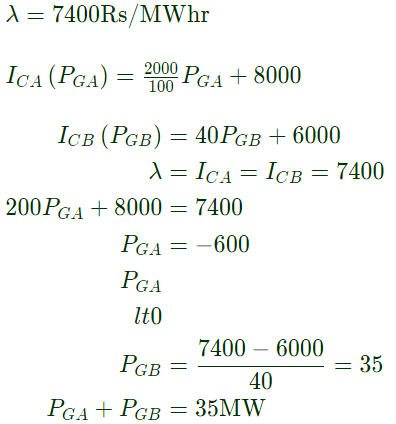
Q2: The fuel cost functions in rupees/hour for two 600 MW thermal power plants are given by
 where P1 and P2 are power generated by plant 1 and plant 2, respectively, in MW and aa is constant. The incremental cost of power (λ) is 8 rupees per MWh. The two thermal power plants together meet a total power demand of 550 MW. The optimal generation of plant 1 and plant 2 in MW, respectively, are (2022)
where P1 and P2 are power generated by plant 1 and plant 2, respectively, in MW and aa is constant. The incremental cost of power (λ) is 8 rupees per MWh. The two thermal power plants together meet a total power demand of 550 MW. The optimal generation of plant 1 and plant 2 in MW, respectively, are (2022)
(a) 200, 350
(b) 250, 300
(c) 325, 225
(d) 350, 200
Ans: (b)
Sol:  For optimum generation,
For optimum generation,
IC1 = IC2 = λ
Therefore, 6 + 0.008P1 = 8

Q3: Two generators have cost functions F1 and F2. Their incremental-cost characteristics are
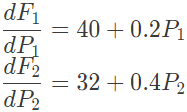 They need to deliver a combined load of 260 MW. Ignoring the network losses, for economic operation, the generations P1 and P2 (in MW) are (2021)
They need to deliver a combined load of 260 MW. Ignoring the network losses, for economic operation, the generations P1 and P2 (in MW) are (2021)
(a) P1 = P2 = 130
(b) P1 = 160, P2 = 100
(c) P1 = 140, P2 = 120
(d) P1 = 120, P2 = 140
Ans: (b)
Sol: 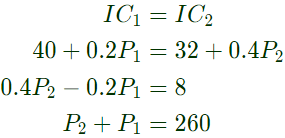 Solving equation (i) and (ii),
Solving equation (i) and (ii),
P1 = 160MW; P2 = 100MW
Q4: Two generating units rated 300 MW and 400 MW have governor speed regulation of 6% and 4% respectively from no load to full load. Both the generating units are operating in parallel to share a load of 600 MW. Assuming free governor action, the load shared by the larger unit is _______ MW. (SET-2 (2017))
(a) 50
(b) 100
(c) 200
(d) 400
Ans: (d)
Sol: Given: speed regulation of generating unit is from no load to full load.
Hence, the rated frequency (50 Hz) will be common for both units at no load nad will drop to lower value as loaded to full load.
Let, P1= Load shared by 400 MW machine
P2= Load shred by 300 MW machine
For 400 MW machine drop in frequency from no load to full load = 
New frequecy of operation of 400 MW machine, 
For 300 MW machine drop in frequency from no load to full load 
New frequecy of operation of 300 MW machine, 
we also know,
P1 + P2 = 600
(Load shared between shared units)
 (Units operatio is in parallel)
(Units operatio is in parallel)
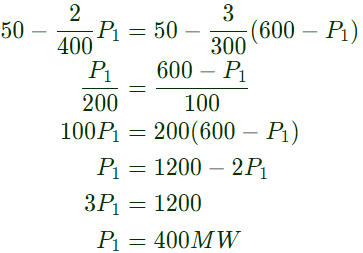
Q5: The incremental costs (in Rupees/MWh) of operating two generating units are functions of their respective powers P1 and P2 in MW, and are given by
 where
where
 For a certain load demand, P1 and P2 have been chosen such that dC1/dP1 = 76Rs/MWh and dC2/dP2 = 68.8 Rs/MWh. If the generations are rescheduled to minimize the total cost, then P2 is ________. (SET-2(2015))
For a certain load demand, P1 and P2 have been chosen such that dC1/dP1 = 76Rs/MWh and dC2/dP2 = 68.8 Rs/MWh. If the generations are rescheduled to minimize the total cost, then P2 is ________. (SET-2(2015))
(a) 76.78
(b) 120.24
(c) 136.36
(d) 156.84
Ans: (c)
Sol: 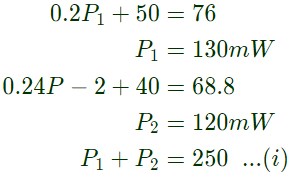 For minimized schedule,
For minimized schedule,
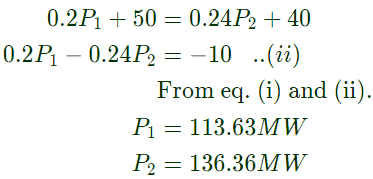
Q6: Consider the economic dispatch problem for a power plant having two generating units. The fuel costs in Rs/MWh along with the generation limits for the two units are given below:
 The incremental cost (in Rs/MWh) of the power plant when it supplies 200 MW is ______ . (SET-1(2015))
The incremental cost (in Rs/MWh) of the power plant when it supplies 200 MW is ______ . (SET-1(2015))
(a) 10
(b) 20
(c) 30
(d) 40
Ans: (b)
Sol: 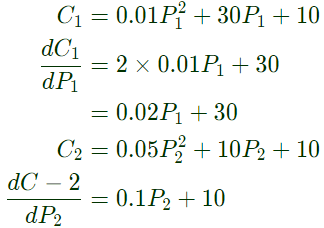 For optimum incremental cost,
For optimum incremental cost,
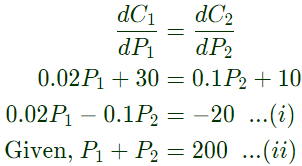
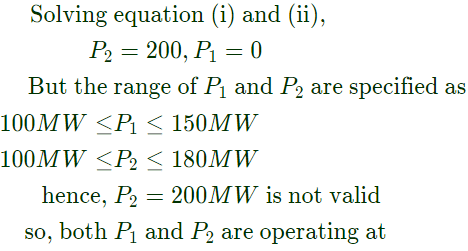

Q7: The fuel cost functions of two power plants are
 where, Pg1 and Pg2 are the generated powers of two plants, and A and B are the constants. If the two plants optimally share 1000 MW load at incremental fuel cost of 100 Rs/MWh, the ratio of load shared by plants P1 and P2 is (SET-1 (2014))
where, Pg1 and Pg2 are the generated powers of two plants, and A and B are the constants. If the two plants optimally share 1000 MW load at incremental fuel cost of 100 Rs/MWh, the ratio of load shared by plants P1 and P2 is (SET-1 (2014))
(a) 1:4
(b) 2:3
(c) 3:2
(d) 4:1
Ans: (d)
Sol: Given, Pg1 + Pg2 = 1000...(i)
Also, incremental cost of production of
 and incremental cost of production of
and incremental cost of production of
 For optimum load sharing
For optimum load sharing
 Putting this value in equation (ii), we have
Putting this value in equation (ii), we have
 Using equation (iv) and (v), we have:
Using equation (iv) and (v), we have:

Q8: The figure shows a two-generator system applying a load of PD = 40MW, connected at bus 2.
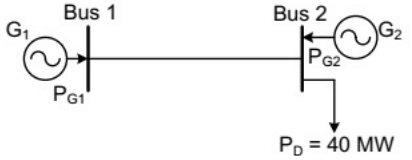 The fuel cost of generators G1 and G2 are :
The fuel cost of generators G1 and G2 are :
C1(PG1) = 10,000 Rs/MWh and C2(PG2) = 12,500 Rs/MWh and the loss in the line is  where the loss coefficient is specified in pu on a 100 MVA base. The most economic power generation schedule in MW is (2012)
where the loss coefficient is specified in pu on a 100 MVA base. The most economic power generation schedule in MW is (2012)
(a) PG1 = 20, PG2 = 22
(b) PG1 = 22, PG2 = 20
(c) PG1 = 20, PG2 = 20
(d) PG1 = 0, PG2 = 40
Ans: (a)
Sol: From cordination equation
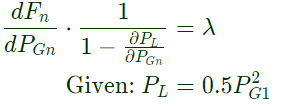
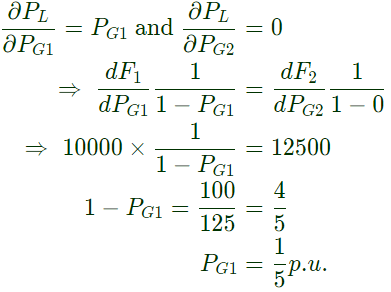 as the base value is 100 MVA
as the base value is 100 MVA

Q9: A load center of 120 MW derives power from two power stations connected by 220 kV transmission lines of 25 km and 75 km as shown in the figure below. The three generators G1, G2 and G3 are of 100 MW capacity each and have identical fuel cost characteristics. The minimum loss generation schedule for supplying the 120 MW load is (2011)
 (a) P1 = 80MW+losses, P2 = 20MW, P3 = 20MW
(a) P1 = 80MW+losses, P2 = 20MW, P3 = 20MW
(b) P1 = 60MW, P2 = 30MW + losses, P3 = 30MW
(c) P1 = 40MW, P2 = 40MW, P3 = 40MW + losses
(d) P1 = 30MW+losses, P2 = 45MW, P3 = 45MW
Ans: (a)
Sol:  Let load center is connected at point x
Let load center is connected at point x
If r is resistance/km of line
Resistance of section between 1 nad x
R1 = r × 25 = R
Resistance of section between x nad 2
R2 = r × 75 = 3R
Current (I) fed by generator ∝∝ power produced by the generator.
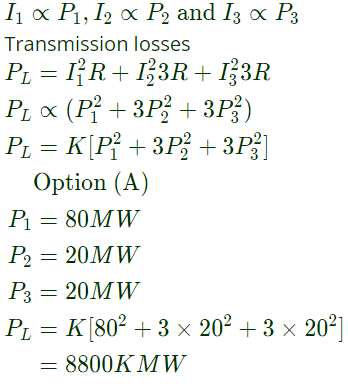
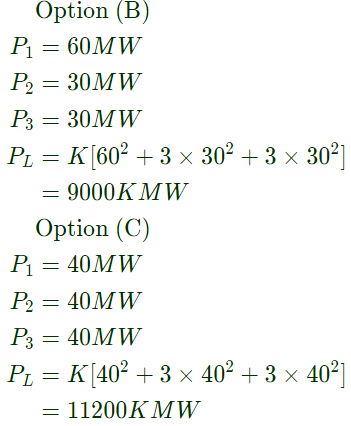
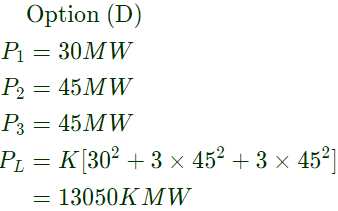 So, option (A) gives minimum losses.
So, option (A) gives minimum losses.
Q10: Three generators are feeding a load of 100 MW. The details of the generators are

In the event of increased load power demand, which of the following will happen ? (2009)
(a) All the generator will share equal power
(b) Generator-3 will share more power compared to Generator-1
(c) Generator-1 will share more power compared to Generator-2
(d) Generator-2 will share more power compared to Generator-3
Ans: (c)
Sol: Let x1, x2 and x3 are reactance of generator-1, generator-2 and generator-3 respectively.
Neglecting armature resistance of all the three generators
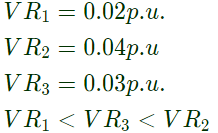 Since, voltage regulation (VR) ∝ reactance of generator .
Since, voltage regulation (VR) ∝ reactance of generator .
X1 < X3 < X2
Power shared by a generator 
Power shared by Generator 1 > Generator 2 > Generator 3.
Q11: A loss less power system has to serve a load of 250 MW. There are tow generation (G1 and G2) in the system with cost curves C1 and C2 respectively defined as follows:
 where PG1 and PG2 are the MW injections from generator G1 and G2 respectively. Thus, the minimum cost dispatch will be (2008)
where PG1 and PG2 are the MW injections from generator G1 and G2 respectively. Thus, the minimum cost dispatch will be (2008)
(a) PG1 = 250MW; PG2 = 0MW
(b) PG1 = 150MW; PG2 = 100MW
(c) PG1 = 100MW; PG2 = 150MW
(d) PG1 = 0MW; PG2 = 250MW
Ans: (c)
Sol: 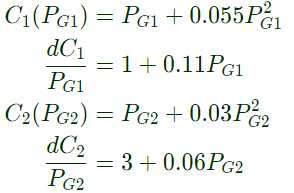 For minimum cost analysis
For minimum cost analysis
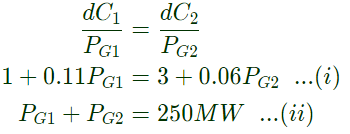 Solving equation (i) and (ii),
Solving equation (i) and (ii),
we get, PG1 = 100MW and PG2 = 150MW
Q12: The incremental cost curves in Rs/MWhr for two generators supplying a common load of 700 MW are shown in the figures. The maximum and minimum generation limits are also indicated. The optimum generation schedule is : (2007)
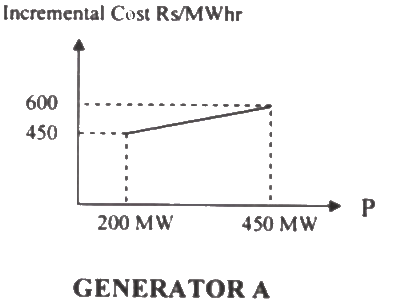
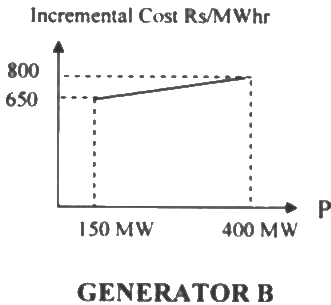 (a) Generator A : 400 MW, Generator B : 300 MW
(a) Generator A : 400 MW, Generator B : 300 MW
(b) Generator A : 350 MW, Generator B : 350 MW
(c) Generator A : 450 MW, Generator B : 250 MW
(d) Generator A : 425 MW, Generator B : 275 MW
Ans: (c)
Sol: Maximum incremental cost in Rs/Mwhr for generator A =600 (at 450 MW)
Minimum incremental cost in Rs/Mwhr for generator B = 650 (at 150 MW)
As maximum value of incremental cost of A is less than minimum value of B.
Therefore, generator 'A' will operate at its maximum (o/p) 450 MW and B at (700 - 450) = 250 MW.
Q13: A load centre is at an equidistant from the two thermal generating stations G1 and G2 as shown in the figure. The fuel cost characteristic of the generating stations are given by
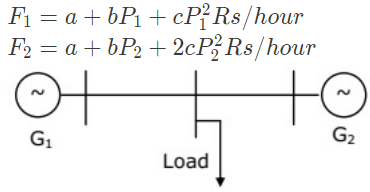 Where P1 and P2 are the generation in MW of G1 and G2, respectively. For most economic generation to meet 300 MW of load P1 and P2 respectively, are (2005)
Where P1 and P2 are the generation in MW of G1 and G2, respectively. For most economic generation to meet 300 MW of load P1 and P2 respectively, are (2005)
(a) 150, 150
(b) 100, 200
(c) 200, 100
(d) 175, 125
Ans: (c)
Sol: Fuel-cost curve of generating station 1
 Fuel-cost curve of generating station 2
Fuel-cost curve of generating station 2
 The slope of the fuel-cost curve i.e.
The slope of the fuel-cost curve i.e.  is called the incremental fuel-cost (IC) and is expressed in Rs/MWh.
is called the incremental fuel-cost (IC) and is expressed in Rs/MWh.
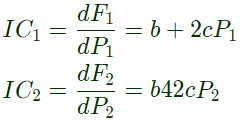 For economic generation
For economic generation
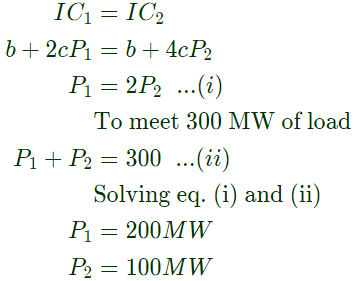
Q14: Incremental fuel costs (in some appropriate unit) for a power plant consisting of three generating units are
 Where P1 is the power in MW generated by unit i for i = 1, 2 and 3. Assume that all the three units are operating all the time. Minimum and maximum loads on each unit are 50 MW and 300 MW respectively. If the plant is operating on economic load dispatch to supply the total power demand of 700 MW, the power generated by each unit is (2003)
Where P1 is the power in MW generated by unit i for i = 1, 2 and 3. Assume that all the three units are operating all the time. Minimum and maximum loads on each unit are 50 MW and 300 MW respectively. If the plant is operating on economic load dispatch to supply the total power demand of 700 MW, the power generated by each unit is (2003)
(a) P1 = 242.86MW; P2 = 157.14MW; and P3 = 300MW
(b) P1 = 157.14MW; P2 = 242.86MW; and P3 = 300MW
(c) P1 = 300MW; P2 = 300MW; and P3 = 100MW
(d) P1 = 233.3MW; P2 = 233.3MW; and P3 = 233.4MW
Ans: (a)
Sol: When P1 is minimum i.e. P1 = 50MW
IC1 = 20 + 0.3 × 50 = 35
When P2 is minimum i.e. P2 = 50MW
IC2 = 30 + 0.4 × 50 = 50
For minimum value of P1 and P2
IC1 and IC2 > IC3
Therefore,
P3 = 300MW
[maximum load is assigned to unit 3]
Remaining power is to shared by unit 1 and 2
So, P1 + P2 = 700 − 300 = 400MW...(i)
For optimal operation,
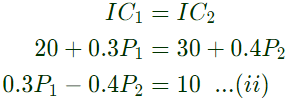 Solving equation (i) and (ii), we get
Solving equation (i) and (ii), we get

Q15: Consider a power system with three identical generators. The transmission losses are negligible. One generator (G1) has a speed governor which maintains its speed constant at the rated value, while the other generators (G2 and G3) have governors with a droop of 5%. If the load of the system is increased, then in steady state. (2002)
(a) generation of G2 and G3 is increased equally while generation of G1 is unchanged
(b) generation of G1 alone is increased while generation of G2 and G3 is unchanged.
(c) generation of G1, G2 and G3 is increased equally.
(d) generation of G1, G2 and G3 is increased in the ratio 0.5:0.25:0.25.
Ans: (b)
 (a) 26
(a) 26
 where P1 and P2 are power generated by plant 1 and plant 2, respectively, in MW and aa is constant. The incremental cost of power (λ) is 8 rupees per MWh. The two thermal power plants together meet a total power demand of 550 MW. The optimal generation of plant 1 and plant 2 in MW, respectively, are (2022)
where P1 and P2 are power generated by plant 1 and plant 2, respectively, in MW and aa is constant. The incremental cost of power (λ) is 8 rupees per MWh. The two thermal power plants together meet a total power demand of 550 MW. The optimal generation of plant 1 and plant 2 in MW, respectively, are (2022) For optimum generation,
For optimum generation,
 They need to deliver a combined load of 260 MW. Ignoring the network losses, for economic operation, the generations P1 and P2 (in MW) are (2021)
They need to deliver a combined load of 260 MW. Ignoring the network losses, for economic operation, the generations P1 and P2 (in MW) are (2021) Solving equation (i) and (ii),
Solving equation (i) and (ii),



 (Units operatio is in parallel)
(Units operatio is in parallel)
 where
where For a certain load demand, P1 and P2 have been chosen such that dC1/dP1 = 76Rs/MWh and dC2/dP2 = 68.8 Rs/MWh. If the generations are rescheduled to minimize the total cost, then P2 is ________. (SET-2(2015))
For a certain load demand, P1 and P2 have been chosen such that dC1/dP1 = 76Rs/MWh and dC2/dP2 = 68.8 Rs/MWh. If the generations are rescheduled to minimize the total cost, then P2 is ________. (SET-2(2015)) For minimized schedule,
For minimized schedule,
 The incremental cost (in Rs/MWh) of the power plant when it supplies 200 MW is ______ . (SET-1(2015))
The incremental cost (in Rs/MWh) of the power plant when it supplies 200 MW is ______ . (SET-1(2015)) For optimum incremental cost,
For optimum incremental cost,


 where, Pg1 and Pg2 are the generated powers of two plants, and A and B are the constants. If the two plants optimally share 1000 MW load at incremental fuel cost of 100 Rs/MWh, the ratio of load shared by plants P1 and P2 is (SET-1 (2014))
where, Pg1 and Pg2 are the generated powers of two plants, and A and B are the constants. If the two plants optimally share 1000 MW load at incremental fuel cost of 100 Rs/MWh, the ratio of load shared by plants P1 and P2 is (SET-1 (2014)) and incremental cost of production of
and incremental cost of production of For optimum load sharing
For optimum load sharing Putting this value in equation (ii), we have
Putting this value in equation (ii), we have Using equation (iv) and (v), we have:
Using equation (iv) and (v), we have:
 The fuel cost of generators G1 and G2 are :
The fuel cost of generators G1 and G2 are : where the loss coefficient is specified in pu on a 100 MVA base. The most economic power generation schedule in MW is (2012)
where the loss coefficient is specified in pu on a 100 MVA base. The most economic power generation schedule in MW is (2012)
 as the base value is 100 MVA
as the base value is 100 MVA
 (a) P1 = 80MW+losses, P2 = 20MW, P3 = 20MW
(a) P1 = 80MW+losses, P2 = 20MW, P3 = 20MW Let load center is connected at point x
Let load center is connected at point x

 So, option (A) gives minimum losses.
So, option (A) gives minimum losses.
 Since, voltage regulation (VR) ∝ reactance of generator .
Since, voltage regulation (VR) ∝ reactance of generator .
 where PG1 and PG2 are the MW injections from generator G1 and G2 respectively. Thus, the minimum cost dispatch will be (2008)
where PG1 and PG2 are the MW injections from generator G1 and G2 respectively. Thus, the minimum cost dispatch will be (2008) For minimum cost analysis
For minimum cost analysis Solving equation (i) and (ii),
Solving equation (i) and (ii),
 (a) Generator A : 400 MW, Generator B : 300 MW
(a) Generator A : 400 MW, Generator B : 300 MW Where P1 and P2 are the generation in MW of G1 and G2, respectively. For most economic generation to meet 300 MW of load P1 and P2 respectively, are (2005)
Where P1 and P2 are the generation in MW of G1 and G2, respectively. For most economic generation to meet 300 MW of load P1 and P2 respectively, are (2005) Fuel-cost curve of generating station 2
Fuel-cost curve of generating station 2 The slope of the fuel-cost curve i.e.
The slope of the fuel-cost curve i.e.  is called the incremental fuel-cost (IC) and is expressed in Rs/MWh.
is called the incremental fuel-cost (IC) and is expressed in Rs/MWh. For economic generation
For economic generation
 Where P1 is the power in MW generated by unit i for i = 1, 2 and 3. Assume that all the three units are operating all the time. Minimum and maximum loads on each unit are 50 MW and 300 MW respectively. If the plant is operating on economic load dispatch to supply the total power demand of 700 MW, the power generated by each unit is (2003)
Where P1 is the power in MW generated by unit i for i = 1, 2 and 3. Assume that all the three units are operating all the time. Minimum and maximum loads on each unit are 50 MW and 300 MW respectively. If the plant is operating on economic load dispatch to supply the total power demand of 700 MW, the power generated by each unit is (2003) Solving equation (i) and (ii), we get
Solving equation (i) and (ii), we get





















